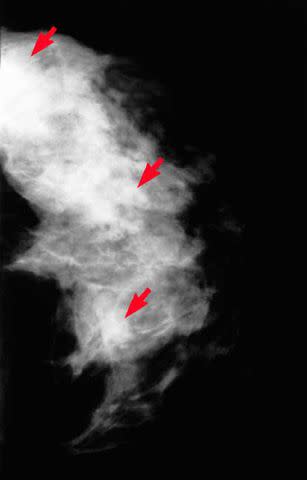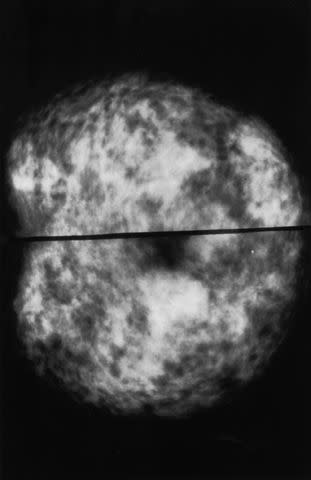Breast Asymmetry: Is It a Sign of Cancer?
Medically reviewed by Rony Kampalath, MD
Breast asymmetry on a mammogram report means that part of one breast looks different from the other at the same site or part of the breast. With focal asymmetry, it means the area is identified in two or more views of the mammogram, often due to benign (not harmful) changes.
Yet a significant variation or sudden change in aspects, such as density, could indicate a problem. Developing asymmetry can be a more concerning finding because it represents a change from previous images. Your healthcare provider will discuss results and further tests with you.
Learn more about breast asymmetry, its causes, how it relates to cancer, testing, and more.

What Is Asymmetry?
Asymmetry results on a mammogram indicate that the image shows something different on one breast when compared to the same site of the other breast. Tissue within the same breast also is evaluated.
Types of breast asymmetry seen on a mammogram include:
Focal asymmetry: A difference in the breast seen on two or more mammogram images. This is typically a small, localized site with assessment based on the same location in the other breast. It is seen in about 21% of all mammograms and is not typically cancer.
One-view asymmetry: A focal asymmetry that's seen in only one view of a mammogram. It occurs up to 20.5% of the time, often due to benign fibroglandular (density) changes.
Global asymmetry: More breast tissue involved in one breast or one area of a breast than seen in focal asymmetry. This occurs in about 3% of mammograms and is considered a normal variant.
Developing asymmetry: Focal asymmetry that appears to grow or change compared to previous tests. It occurs in up to 4.4% of cases, and can be due to benign or malignant causes.
When breast asymmetry is detected, additional testing may be recommended. An asymmetry is present in about 6% of breast cancers detected on mammogram screening, but it also is a common reason for recall tests that turn out to be false alarms with no cancer present.
Takeaway
A study of 201 people with four different types of breast asymmetry found six cases of an invasive breast cancer and two cases of ductal carcinoma in situ (DCIS), with benign causes in all other cases. Focal asymmetry accounted for six of the eight, with developing symmetry in the other breast cancer cases.
Related: Normal and Abnormal Mammogram Images

Causes of Breast Asymmetry
Benign causes of breast asymmetry on mammogram include the following:
Fibrocystic changes: Cysts filled with fluid and scar tissue in the area of the cysts
Dense stromal fibrosis: The connective tissue in that area of the breast is denser than it is in other areas
Pseudoangiomatous stromal hyperplasia: A lump of non-cancerous cells that grows in the breast
Breast Asymmetry Causes
Growths, such as fibroids or cysts
Dense breast tissue
Lumps or masses
Is Asymmetry a Sign of Cancer?
It is unclear how breast asymmetry impacts cancer risk, and it may depend on the cause of breast asymmetry. For example, fibrocystic changes do not increase cancer risk, nor does pseudoangiomatous stromal hyperplasia.
Stromal fibrosis can increase the risk of breast cancer and may be associated with inaccurate biopsies. This can happen when non-cancerous stromal fibrosis is located next to cancerous cells; a biopsy sample containing the non-cancerous stromal fibrosis is taken without catching any cancerous cells.
While breast asymmetry is not usually indicative of cancer, medical professionals may recommend testing to be sure.

What Happens If Your Mammogram Shows Asymmetry?
When breast asymmetry is found on a mammogram, additional screening tests are usually recommended to rule out breast cancer. Further testing should not be a major reason for concern; many people with breasts who have a screening mammogram are asked to undergo additional testing, and less than 10% of them receive a breast cancer diagnosis.
A diagnostic mammogram is often the next step. It is similar to a screening mammogram but with additional images of the asymmetric area. 3D tomosynthesis, which uses X-ray technology like a mammogram, can take images from more angles, providing a more accurate result.
Types of Additional Screening for Breast Asymmetry
Digital breast tomosynthesis (3D mammogram)
Diagnostic mammogram
The type of follow-up testing also depends on what is found on the screening mammogram:
Focal symmetry: Six-month follow-up imaging for findings without suspicious features
One-view symmetry: Same six-month approach as focal symmetry findings
Global asymmetry: Likely do not require follow-up in the absence of suspicious features
Developing asymmetry: More concerning due to changes and may require biopsy
Sometimes a combination of additional tests is recommended.
Outlook
Breast asymmetry is usually entirely normal and does not indicate an increased risk for cancer. However, it is important to see your healthcare provider for an evaluation and follow through with any recommended testing.
If the initial mammogram result of breast asymmetry does lead to a breast cancer diagnosis, it is a treatable condition with high survival rates.
Related: When Can I Say I Am a Breast Cancer Survivor?
Summary
Breast asymmetry means that a specific breast area appears different from the tissue at the same site on the other breast. When found on a mammogram, it can be but usually is not a sign of cancer.
Even so, additional testing, such as a diagnostic mammogram or 3D tomosynthesis, may be recommended to ensure breast cancer is not overlooked. Talk with your healthcare provider about your concerns, any symptoms, or the tests needed to evaluate your breast asymmetry.
Read the original article on Verywell Health.

